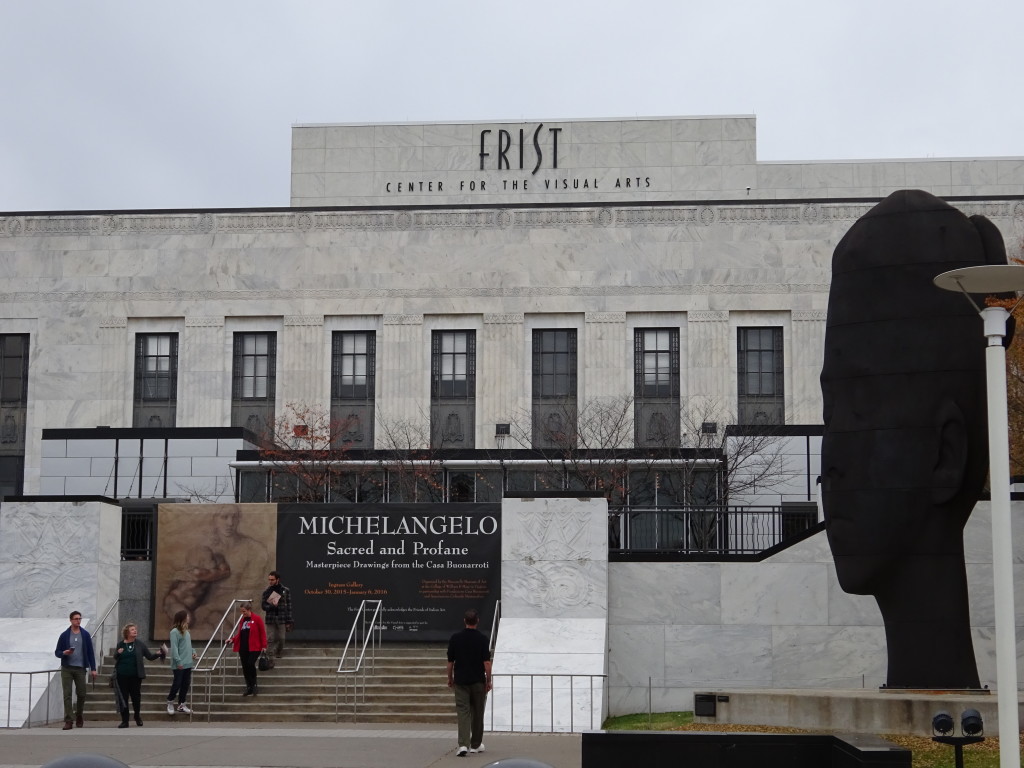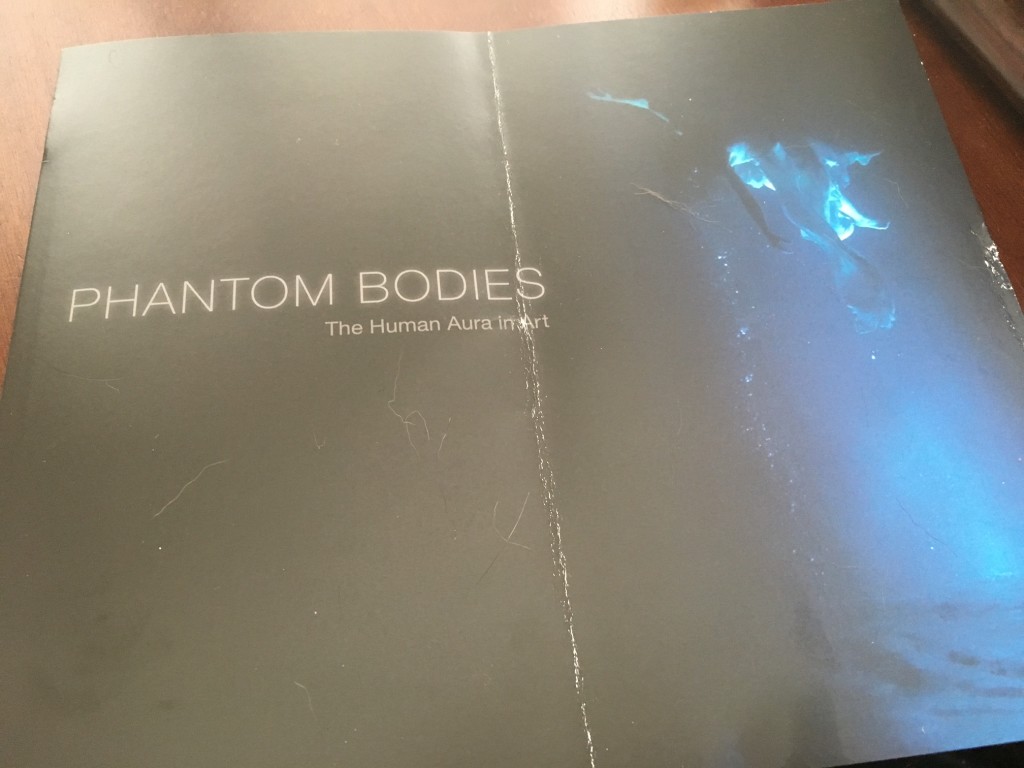
Valentine’s Day was the last day for the Phantom Bodies: The Human Aura in Art exhibit at the Frist Center for Visual Arts. I’ve been meaning to write about the exhibit ever since we went to see it in early December, but…well, between the busy holidays and getting Shadow People and Cursed Objects: 13 Tales of Terror Based on True Stories…or are they? together, there was no time.
However, I can’t let it leave without commenting on what an awesome exhibit it was. Chilling. Haunting. Provocative. Immensely creative. It left an impact.
Photos weren’t allowed so I was only able to take a photo of the Phantom Bodies Gallery Guide.

Here is the introduction from inside the guide:
People often feel the presence of someone when no one is there. This may be a way of giving form to the fear of the unknown, the ghost in the closet. It may be a near-palpable memory of an absent loved one, triggered by an article of clothing, a photograph, a scent, an old recording. And it can even be a feeling of being close to the spirit or soul of someone who has died. Regardless of the source, the sense of presence-in-absence fills a deep need to experience a human essence outside the body.
This exhibition includes artwork that indicate such presences through surrogates: shadows, imprints, or masks; objects as memento mori; or forms of pure energy. The title is derived from the phenomenon known as phantom limb syndrome. Those experiencing this have lost some part of their bodies but feel it to be still present. While it is a source of sensation and frequently of pain, the phantom limb here symbolizes the longing to fill the empty spaces that accrue through the lives of individuals and cultures.
The exhibit was divided into four sections:
- Objects and Absence
- Violence, Empathy, and Erasure
- Sublimation
- The Mind-Body Problem
There were all kinds of works on display: sculptures, paintings, photographs, videos…it was a very diverse array. The works in the Violence, Empathy, and Erasure section shocked, saddened, and moved me the most. They are the ones that have haunted me ever since, and made me want to write this post. They included:
- Erased Lynchings by Ken Gonzales-Day
- One Big Self: Prisoners of Louisiana by Deborah Luster
- Lote Bravo by Teresa Margolles
- Ajuste de Cuentas also by Teresa Margolles
Haunting Photos
One of the ones that chilled me most was Erased Lynchings. It consisted of a group of black and white photographs that at first captured my attention just because of how paranormal they looked.
At first glance, they looked like something was missing. But at the same time like something was there. An essence of sorts. Something that was drawing the people’s attention in the photos who were focused on this missing piece.
Well, it was quite the jolt when I read the information to go along with this work and discovered that indeed something was missing: bodies.
Ken Gonzales-Day collected historical photos of lynchings and digitally removed the bodies. All that’s left is the people who were responsible for the hangings or those who were curious and came to see the aftermath. The end result is both a gruesome and haunting piece of art, and yet beautiful too. But very sad.
Once I realized what I was looking at, I felt sick. And grateful. Grateful I had not been raised in such an ignorant community that would kill someone for sport-but-under-the-guise-of-justice just because of the person’s ethnicity or skin color.
To see his Erased Lynchings photos, click here. Then use the “<>” in the upper right hand corner beside the word “Images” to scroll through them.
Deborah Luster’s work also included some very haunting, very novel photographic images. After her mother was murdered, she sought to make sense of the violence by taking portraits of inmates in Louisiana’s jails. But she didn’t just take them sitting in their cell or getting a slice of their prison life. (Except for inmates at Angola, where she photographed them out in the cotton fields, where they still pick cotton. However, she didn’t photograph them doing that. It was just a chance to shoot them outside, instead of with her trademark black background.)
The photos included in her work at Frist’s Phantom Bodies exhibit that drew my attention were ones that looked like old Halloween costumes photos. (The way she processes her photos, they have that old timey, sepia look to them.) Turned out it was photos of women inmates from San Gabriel and their Mardi Gras celebrations and Halloween haunted house. (Apparently they create a haunted house and also get to create their own costumes. That’s something I’d like to look into further and write more about.)
Anyway, here is a video I found of Deborah Luster’s One Big Self: Prisoners of Louisiana photos so you can get an idea of what she does. (Which is actually quite touching. She wants to portray their humanity. Here’s an excellent article about it on KitchenSisters.org.)
Haunting Memento Mori
The other artist who it turned out had two works in the exhibit, both of which impacted me, was Teresa Margolles.
Her Lote Bravo didn’t look like much at first. It just looked like a brick wall really. Extremely unassuming, and maybe even a little boring. What’s so special about a stack of bricks made from mud?
Well, they were created from the sand where hundreds of bodies of murdered women have been found in Ciudad Juárez. Once I learned that, I got goosebumps.
Her other work was also sort of unassuming. And pretty. It was jewelry. What’s so special or ethereal about that?
Well, the “diamonds” were made from the shattered shards of glass from drive-by shootings in Sinaloa. (a.k.a. A major hot bed of Mexican drug war violence.)
If none of that gives you chills, maybe these poetic words about her works in the Phantom Bodies Gallery Guide will:
The possibility of residual DNA in the bricks and glass adds emotional power, reminding us that many artworks have the blood of the oppressed to thank for their existence.
The Mystery Work
There was also a very haunting work that I can neither figure out the title of nor the artist behind. It was a diorama of a darkened movie theater. There was a movie playing on the screen. You put headphones on and listened as if you were inside a theater goer’s mind. A woman. She was eating popcorn, commenting on the movie, saying she’d seen it in a dream.
Then lines became blurred. Were you inside her head? Really watching the movie? Watching something else play out?
A gun is fired. There’s a scream. A shot in the dark? Is anyone in the theater killed? Or did it happen on screen?
It was an extremely surreal, unsettling experience because of the sound. The headphones blocked off all reality and immersed you into this tiny, strange world.
I wish I knew who to credit. It was just another of the remarkable displays.
Phantom Bodies Next Exhibition
The tour continues in Florida at the John and Mable Ringling Museum of Art in Sarasota, Florida: June 17–September 11, 2016.
I’ve never been to Sarasota or that museum. It’d be an incredibly hot time to go (the older I get, the less I like sweating), but I could add a new city to my list, as well as a new museum, and see this exhibit again. Which I’d like to. I don’t think once was enough.
Courtney Mroch is a globe-trotting restless spirit who’s both possessed by wanderlust and the spirit of adventure, as well as obsessed with true crime, horror, the paranormal, and weird days. Perhaps it has something to do with her genes? She is related to occult royalty, after all. Marie Laveau, the famous Voodoo practitioner of New Orleans, is one of her ancestors. That could also explain her infatuation with skeletons.
Speaking of healing, to learn how she channeled her battle with cancer to conjure up this site, check out HJ’s Origin Story.
